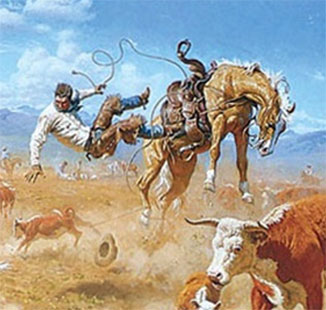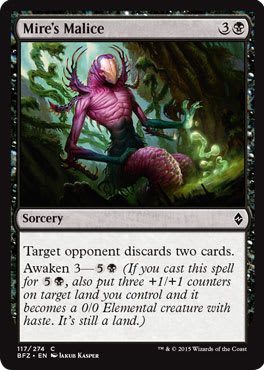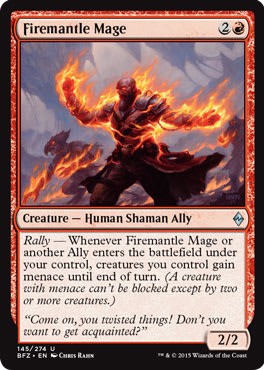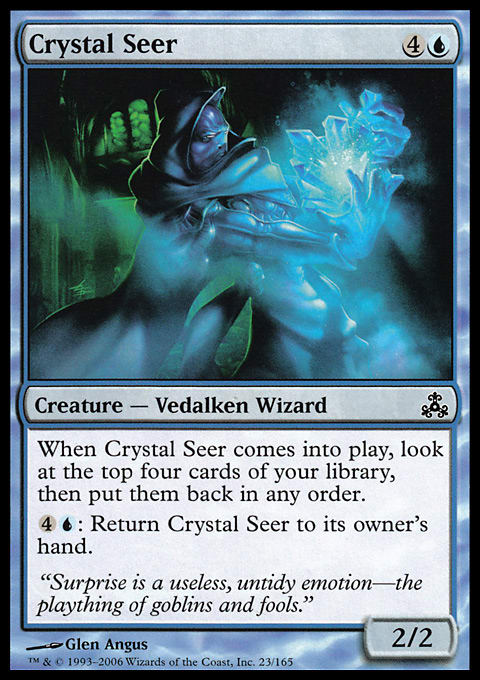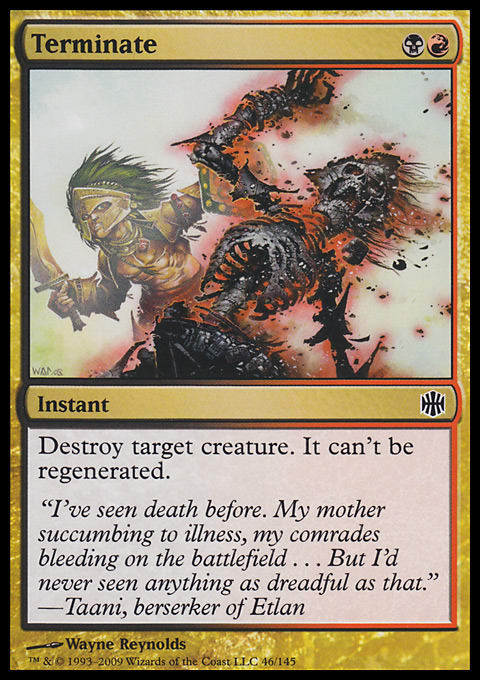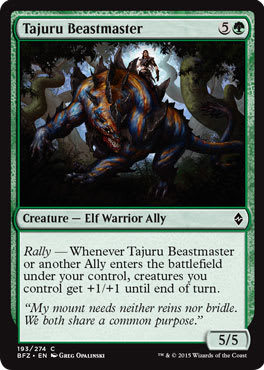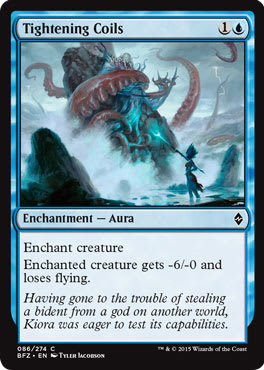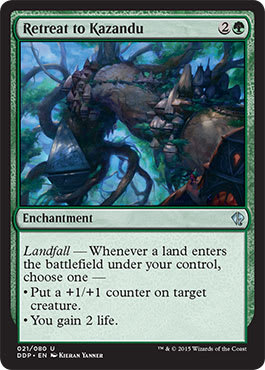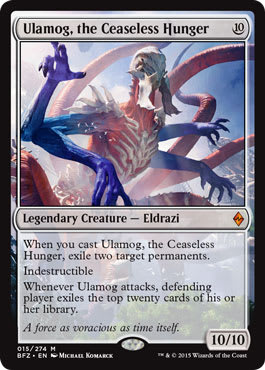The Battle for Zendikar is finally upon us! Ulamog and his brood of land-devouring spawn slowly make their way across the face of the world, consuming everything in their wake. While release day is an exciting time for the Mels of the world, there is plenty for Vorthos to be excited about as well.
It's time for another treasure chest of flavor gems. What is a flavor gem, you ask? Flavor gems are cards that I think deserve a second look by flavor fans everywhere! Get ready, Vorthoses! Today, we are going to be knee-deep in the taste of an unnatural disaster.
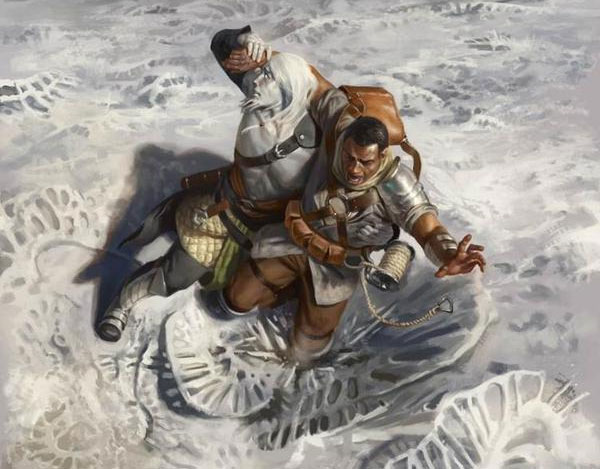
Packaging flavor Gem
Battle for Zendikar has an excellent tagline and set flavor text. Yep, you read that correctly: set flavor text. It surprises me how many people do not realize that each set has its own special flavor text accompanying the tagline. Battle for Zendikar’s tagline “Face Unnatural Disaster” is a play on words that I really enjoyed seeing. Look for both on booster packs and ad inserts everywhere.
Set Flavor Text: Return to the wild plane of Zendikar, where the monstrous Eldrazi threaten the entire world with destruction. The plane’s inhabitants—and the land itself—stand united to oppose them. Answer the call and join the battle for Zendikar!
Card Flavor Gems
When I first read about the awaken mechanic, I immediately started to wonder how Wizards of the Coast’s art directors were going to tackle something so odd. There were bound to be spells like Sheer Drop that did something totally unrelated to creating an elemental out of the land itself, and I couldn’t wait to see how the creative team would tackle such visual puzzles. You can't just show someone being hit by a lightning bolt and then some random elemental in the background. It has to make sense as a cohesive image.
Sheer Drop
Sheer Drop does a fantastic job of communicating both mechanical facets of the card through a single image. We see the land literally coming to life as a nearby kor plummets to his demise. What I really enjoyed about this piece is that it reminds me of old westerns and how there was always a scene showing some inexperienced rider being bucked off his or her horse. The land in Sheer Drop has a similar silhouette to a bucking bronco, violently throwing a kor adventurer off its back.
Mire's Malice
Mire's Malice is another great awaken spell art description, though much more subtle in tone. I recently talked about Mire's Malice on my blog Magic Morsels. What makes this card a gem is its epic art direction. At first glance, this piece appears to depict an Eldrazi syphoning energy from the land, but then your eyes drift upward, and you notice the sinister, snakelike vines looming in the background. That’s when you realize, it’s a trap! Like an angler fish luring in dinner with a glowing lure, Zendikar’s swamplands have drawn this Eldrazi into a clever ambush. The promise of energy is a ruse, and those snakelike vines are about to awaken to a nice helping of Eldrazi for dinner.
Firemantle Mage
Firemantle Mage is unique in the fact that I think this might be a rare instance when the creature this card represents is not the central figure shown in the art. When Firemantle Mage or another Ally enters the battlefield, all your creatures gain menace. This ability is represented by the flames engulfing the human and goblin presented in the art. Naturally, it’s kind of hard to block someone on fire. Initially, you would think the bearded gentleman in the center was the firemantle mage, but on closer inspection, he doesn't look very magelike. If you are observant, you will notice a third figure lurking in the background to the right. This character is much more magelike in appearance and seems to be casting a spell. Perhaps he or she is buffing the two attackers in front of him or her. Could the Firemantle Mage actually be this cloaked figure in the background? It’s possible!
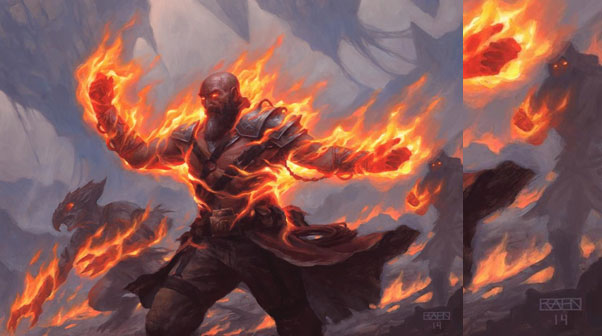
Prism Array
Imagine seeing the following card in a set file that you are responsible for writing art descriptions for:
Enchantment
Mechanic Name — [CARDNAME] enters the battlefield with a [BLANK] counter on it for each color of mana spent to cast it.
Remove a [BLANK] counter from [CARDNAME]: Tap target creature.
![]()
![]()
![]()
![]()
![]() : Scry 3
: Scry 3
Where would you even begin? Tapping down creatures is usually depicted by ice and sleep magic in blue, but how do you tie in both scrying and all five colors to that? Where this card’s description is really clever is that crystal has been used in past art descriptions to showcase multiple colors of mana and seeing into the future. Trapping Eldrazi in crystal was an elegant (and not obvious) solution to this art direction puzzle.
Crumble to Dust
A large portion of Magic gameplay involves removal, and over the years, we have seen numerous renditions of ways in which a Planeswalker can get rid of a creature. From being stomped to death by a trampling minotaur to having a guild symbol bored straight through your chest, Magic has no shortage of creative ways to kill something. What we rarely are able to see is the death of an entire world. The art for Crumble to Dust is beautiful and yet disturbing at the same time. The chalky corruption left behind by Ulamog’s brood creates an image similar to the Alara version of Terminate: one that depicts nothing but dry, skeletal remains on a planar scale.
Tajuru Beastmaster
One of the major jobs flavor text has is to help make sense out of the art and mechanics for the reader. When you first look at the art for Tajuru Beastmaster, you might notice that the elf riding this beast has no means of controlling it. The flavor text for this card is doing a great job in helping to drive home the visual gag being depicted on this card: Both mount and rider are fighting the same cause. Both benefit from seeing the Eldrazi fall, and both are working together to see that it happens.
Kitesail Scout
When writing flavor text for Magic sets, I struggle the most with white cards. A member of the Rakdos guild, I have trouble putting myself in the mindset of the color of law and order. Oddly enough, Law & Order is one of my favorite TV series—SVU to be specific. Anyway, because of the fact that white colors go against my guild and preferred playstyle, whenever a set comes out, the first cards I read are the white cards so that I can learn how other writers approach the color’s values. I really like how this piece outlines a very white reason for wanting to destroy the Eldrazi. This kor is not driven by a selfish desire to continue soaring through the skies, but instead wants to ensure that the following generations or kor can know the joys he has experienced soaring peacefully among the clouds. That’s A+ work.
Tightening Coils
Back in Journey into Nyx when the card Pin to the Earth was revealed, Vorthoses the world over expressed their dislike for the card due to the fact that it was flavored as pinning a creature to the ground but did not mechanically cause the creature to lose flying. Tightening Coils rectifies that flavor oversight in a big way. Not only is the card “strictly better” mechanically, but the cards beautiful art depicts Kiora wielding her newly acquired weapon in dramatic fashion. This is a huge win for Vorthos, as it corrects the ludonarrative dissonance caused by Pin to the Earth with a solid, story-driven card.
Turn Against
The card Turn Against is another hat trick of name, art, and flavor text. The name is a fresh take on card-naming, finding a sweet spot of words that conveys the proper message in the simplest way possible. The art is unsettling to say the least. We have a firsthand view of this human's betrayal seconds after the rope was cut. Looking at the card, we are made to feel betrayed, as though those are our own hands reaching up to be saved. The crown of obsidian ringing our traitor's head is a subtle nod to Kozilek and his brood of mind-altering Eldrazi. The flavor text creates a window into the past, providing us with what were most likely the final words of this hapless adventurer leading up to the moment Nal made the cut.
Retreat to Kazandu
As Planeswalkers, we are akin to explorers, and like the explorers of old, we must be mindful not to accidentally change the native people we encounter for the worse. Something that the creative team has perfected over the years is the art of creating unique, living, and breathing fantasy cultures inhabiting each plane we visit. What I find fascinating about Zendikar is that it is a perfect study into the impact Planeswalkers can have on the planes they visit. Long ago, the kor Planeswalker Nahiri, Ugin, the Spirit Dragon, and the vampire Planeswalker Sorin Markov created the hedron prison you see in every corner of Zendikar as a solution to the Eldrazi threat. Over the millennia that followed, Zendikar’s cultures have been changed by these events in a multitude of ways.
Retreat to Kazandu shows us a refuge deep within Kazandu nestled in the trees next to a large hedron. If you look closely, you can see that the buildings of this refuge are heavily influenced by the hedrons in both shape and structure, showcasing the impact these strange objects have had on the peoples of Zendikar. It’s tough to imagine what it would be like to live in a world in which there were strange, geometric superstructures everywhere with mysterious origins. It makes sense that the ancient peoples would mimic these structures in their architecture, and I loved seeing that represented here.
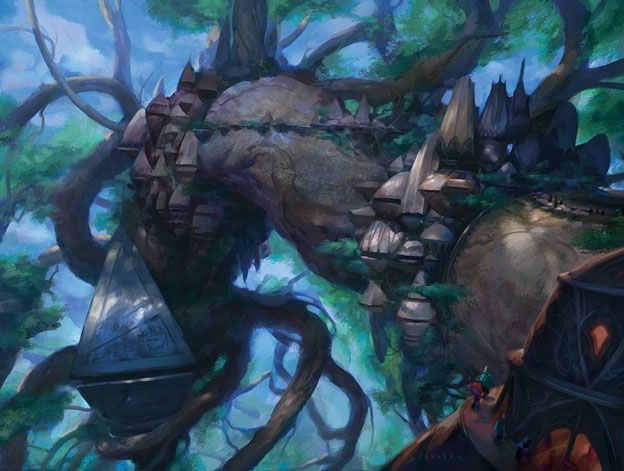
Ulamog, the Ceaseless Hunger
My last flavor gem is a legendary card I pulled from my Fat Pack on release weekend, and I cannot wait to build a flavorful Eldrazi Commander deck around the titan of corruption himself. Ulamog’s new epithet of “Ceaseless Hunger” fits the titan perfectly, the card’s flavor text is eerily ominous, and the art by Michael Komarck is absolutely breathtaking. This card is a mythic in every sense of the word.
Wrapping Up
I hope you enjoyed this trip through the flavor of Battle for Zendikar. Are there any other cards from the set that you believe are flavor gems? Let me know if the comments below!
Until next time, may all your booster packs lead you on flavorful expeditions.
-Ant

















